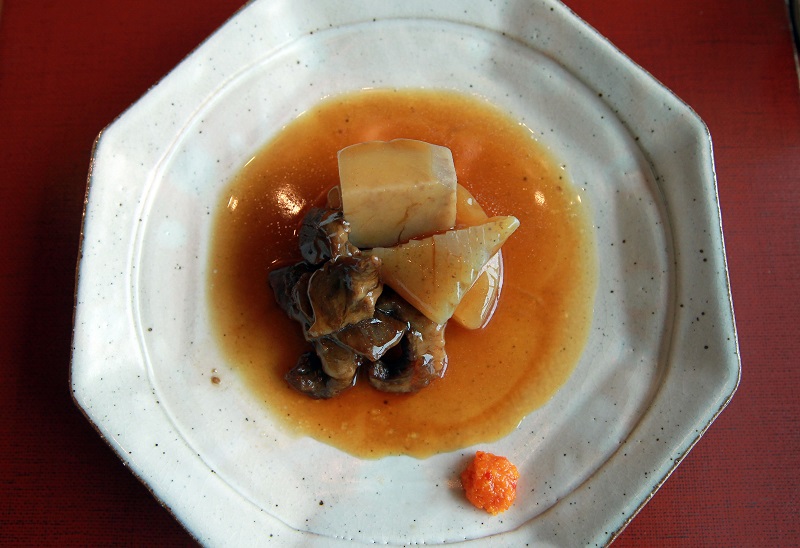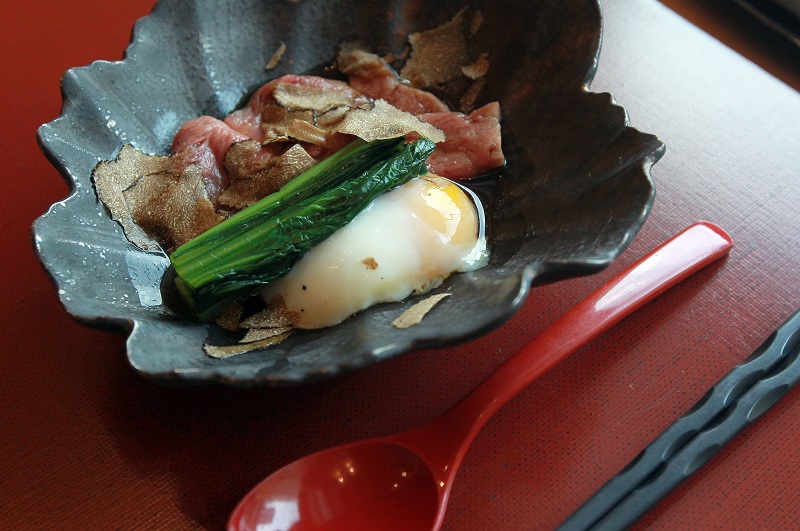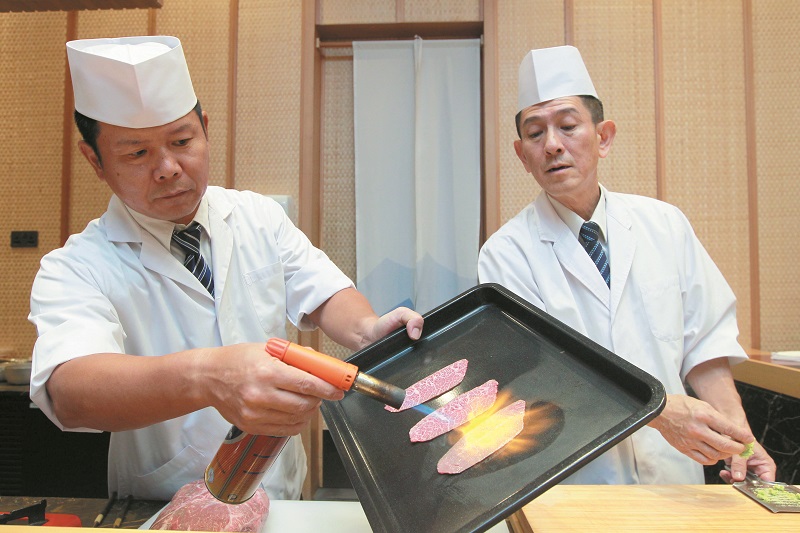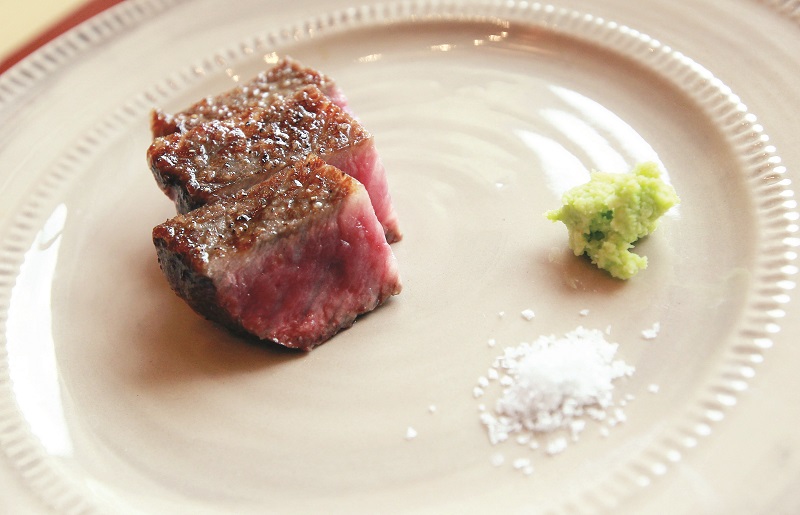
Signature Ozaki wagyu sandwich (All photos: Shahrin Yahya/The Edge)
I’m not sure about you but I crave beef. The bloodier the better. When waiters ask me how I like my steak, my answer is invariably “blue”. Whenever I’m in Paris, it’s no secret that — if left to my own devices — my breakfast, lunch and dinner is steak tartare. There’s something about the flavour of a wonderfully bloody hunk of red meat that makes my mouth water. All the better if it is from a pampered cow of preferably Japanese origin. Much has been made of the mythological magic that comes from a premium, beautiful piece of wagyu whose marbling (referred to as sashi in Japanese) would have made Michelangelo want to carve it.
As most foodies know, the main wagyu districts of Japan are Kobe (Hyogo Prefecture), Matsusaka (Mie Prefecture) and Ohmi (Shiga Prefecture) and the beef tends to be named after its region of origin, that is Matsusaka beef, Kobe beef and so on. So it was a pleasant surprise to learn that the St Regis Kuala Lumpur’s Ushi Pop-Up Restaurant, which will be taking over the existing Ginza Tenkuni tempura establishment, will be the first and only restaurant in Malaysia to serve Ozaki beef.

What’s unusual about Ozaki is that it takes its name, not from a prefecture, but from a certain Muneharu Ozaki of Miyazaki — the only cattle rancher in Japan to market his beef under his own name. Ozaki-san’s brand of beef is also unusual in the fact that the cattle are reared based on advanced American (yes, you read that right) farming techniques and slaughtered at 28 to 36 months old as opposed to the norm of 28 in most parts of Japan. Ozaki-san believes this allows the flavour of the meat to develop while reducing the overwhelming fattiness of the beef, giving it a little more bite, if you will. This sounded most appetising as tucking into a too heavily marbled hunk of meat often leaves me wondering if I had eaten a steak or a stick of Échiré.

For critics who may have baulked at the steep prices of St Regis KL’s Japanese restaurants (the other is Taka by Sushi Saito), Ushi — if not more wallet-friendly — at least gives a better bang for your buck. Priced at RM700+, a maximum of 12 diners each time will get to convene once more around the property’s beautiful bespoke Hinoki cypress wood counter to tuck into a seven-course kaiseki meal.
The debut menu features Ozakigyu prepared in the key Japanese cooking styles or courses. Sakizuke is always the first dish in a formal kaiseki dinner and consists of dainty ingredients, often reflecting the season. Here, executive chef Satoshi Uehara serves up a thin slice of Ozakigyu, aburi-d on one side, and topped with a generous dollop of Hokkaido sea urchin. A smear of seaweed puree and a dab of freshly grated wasabi complete the picture. You are invited to roll up all the ingredients using cypress wood chopsticks before chewing, allowing the various flavours and textures to melt slowly on the tongue. If sakizuke is said to be an invitation to the gods to come partake of the meal, Zeus himself would be tempted to descend Mount Olympus for this.

Hachimono (“dish in a bowl”) comes next — a divine onsen egg and slices of hand-cut beef shoulder lovingly bathed in sukiyaki broth and topped with fresh shavings of black truffle before being anointed with a few drops of truffle oil followed by the nimono (simmered) course. Here, satoimo (taro), konjac and radish are stewed with more heavenly Ozakigyu, tender and wonderful — the kind of meal you would ache for after, say, a thunderstorm or a day out on the slopes.
The next course (agemono or the deep-fried category) is perhaps my most anticipated of the menu and yet the least kaiseki-like. Taking inspiration from Wagyumafia of Tokyo’s headline-grabbing ¥20,000 (about RM800) steak sandwich, chef Satoshi’s version features breaded Ozaki sirloin sandwiched between slices of bread smeared with a sauce made from blueberries, sesame and lemon juice and a blend of French butter, blue cheese and mustard. The luxury protein procession finally comes to a close, going back to basics this time with the yakimono (grilled) course being a study in simplicity — charcoal-grilled sirloin enjoyed just with fresh wasabi and a few grains of Miyazaki sea salt, from the same prefecture as the beef. The menu ends with a rice dish, served atop egg custard and the luxury ingredient du jour or, if you prefer something more comforting, ochazuke and, of course, a palate-cleansing dessert. When I visited, I was delighted to find slices of Indonesian mango, strawberry and, my personal indulgence, a whole Shine Muscat grape. If you are lucky, chef Satoshi might also serve his famous warabimochi or matcha blancmange.

Naturally, a delicate red is the safest bet if you’re looking for a good all-rounder wine to go with your meal here and sommelier Nikki Chan (an Andre Chiang alumna) recommends a Pinot Noir or a nice Rhône. You are welcome to BYOB since Ushi’s wine list is on the lean side, although corkage of RM200 per bottle is levied. Smarty-pants diners are forewarned that any attempt to pass off a magnum as a single bottle will not be looked upon kindly. Ushi does, however, have a stellar sake selection. The one to pick? A Hakkaisan Snow-Aged Junmai Ginjo 3 Years from Niigata that is just about hovering at the RM650 mark. Aged for three years in a yuki muro (snow storehouse), it has a 17% alcohol content and goes beautifully with meat.
For reservations, call (03) 2727 6688. RM700+, a maximum of 12 diners per session; available until Feb 28, 2019. This article first appeared on Oct 1, 2018 in The Edge Malaysia.


